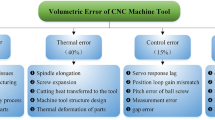Abstract
This paper presents a computational model that defines a methodology for the control, performance evaluation, and calibration of a parallel mechanism by means of the kinematic model, the kinematic parameter identification, and the control of the system actuators and sensors. The developed software has special relevance to the calibration of parallel mechanisms, allowing us to perform the system control, performance evaluation, and mechanism calibration in a single application. Parallel computing techniques are used to overcome the high computational cost involved with solving complex nonlinear kinematic models and parameter identification, obtaining a significant computational cost saving. Finally, the developed procedure is validated, obtaining an important improvement in the accuracy of the mechanism. This methodology can be used in mechanisms for metrology applications and machine tool processes.
Similar content being viewed by others
References
Li Y, Xu Q (2012) Design and robust repetitive control of a new parallel-kinematic XY Piezostage for micro/nanomanipulation. IEEE-ASME Trans Mechatron 17(6):1120–1132
Masouleh MT, Gosselin C (2011) Singularity analysis of 5-RPUR parallel mechanisms (3T2R). Int J Adv Manuf Technol 57:1107–1121
Edinbarough I, Balderas R, Bose S (2005) A vision and robot based on-line inspection monitoring system for electronic manufacturing. Comput Ind 56(8):986–996
Briot S, Bonev IA (2010) Pantopteron-4: a new 3T1R decoupled parallel manipulator for pick-and-place applications. Mech Mach Theory 45(5):707–721
Bajo A, Goldman RE, Wang L (2012) Integration and preliminary evaluation of an insertable robotic effectors platform for single port access surgery. IEEE Conf Robot Autom 1:3381–3387
Wang G, Wang Y, Zhao J (2012) Process optimization of the serial-parallel hybrid polishing machine tool based on artificial neural network and genetic algorithm. J Intell Manuf 23(3):365–374
Moradi M, Shirinzadeh B (2013) Motion control analysis of a parallel robot assisted minimally invasive surgery/microsurgery system (PRAMiSS). Robot Comput Integr Manuf 29(2):318–327
Dalvand MM, Shirinzadeh B (2011) Forward kinematics analysis of offset 6-RRCRR parallel manipulators. Proc Inst Mech Eng C J Mech Eng Sci 225(12):3011–3018
Sangveraphunsiri V, Chooprasird K (2011) Dynamics and control of a 5-DOF manipulator based on an H-4 parallel mechanism. Int J Adv Manuf Technol 52:343–364
Chen J, Lan F (2008) Instantaneous stiffness analysis and simulation for hexapod machines. Simul Model Pract Theory 16(4):419–428
Yao Q, Dong J, Ferreira PM (2007) Design, analysis, fabrication and testing of a parallel-kinematic micropositioning XY stage. Int J Mach Tools Manuf 47(6):946–961
Denavit J, Hartenberg RS (1955) A kinematic notation for lower-pair mechanisms based on matrices. Trans ASME J Appl Mech 22(1):215–221
Chiang MH, Lin HT, Hou CL (2011) Development of a stereo vision measurement system for a 3D three-axial pneumatic parallel mechanism robot arm. Sensors 11(2):2257–2281
Cong D, Yu D, Han J (2006) Kinematic calibration of parallel robots using CMM. Proc The Sixth World Congr Intell Control Autom 2:8514–8518
Lin C, Her J (2005) Calibrating the volumetric errors of a precision machine by a laser tracker system. Int J Adv Manuf Technol 26:1255–1267
Jeon D, Kim K, Jeong J (2010) A calibration method of redundantly actuated parallel mechanism machines based on projection technique. CIRP Ann Manuf Technol 59(1):413–416
Renaud P, Andreff N, Lavest JM (2006) Simplifying the kinematic calibration of parallel mechanisms using vision-based metrology. IEEE Trans Robot 22(1):12–22
Levenberg K (1944) A method for the solution of certain non-linear problems in least squares. Q Appl Math 2(2):164–168
Nategh MJ, Agheli MM (2009) A total solution to kinematic calibration of hexapod machine tools with a minimum number of measurement configurations and superior accuracies. Int J Mach Tools Manuf 49(15):1155–1164
Asanovic K, Bodik R, Catanzaro BC (2006) The landscape of parallel computing research: a view from Berkeley. EECS Dep Univ. Calif Berkeley, Tech. Rep. UCB/EECS-2006-183:2006–2183
Merlet JP (2006) Parallel robots. Kluwer, Dordrecht
Author information
Authors and Affiliations
Corresponding author
Rights and permissions
About this article
Cite this article
Majarena, A.C., Santolaria, J., Samper, D. et al. Computational model for the control, performance evaluation, and calibration of a parallel mechanism. Int J Adv Manuf Technol 69, 1971–1979 (2013). https://doi.org/10.1007/s00170-013-5169-5
Received:
Accepted:
Published:
Issue Date:
DOI: https://doi.org/10.1007/s00170-013-5169-5




